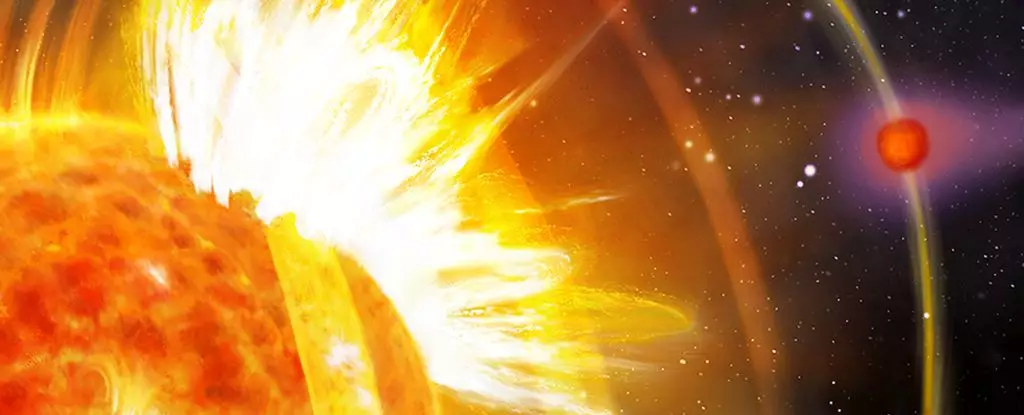In a groundbreaking discovery, astronomers have uncovered a dynamic and tumultuous relationship between a nearby star and its orbiting planet—a relationship that defies long-held assumptions about the independence of stars and their planets. For centuries, stars have been considered massive, self-sufficient celestial bodies, largely unaffected by the small worlds orbiting them. However, recent observations suggest that, under particular conditions, this cosmic independence might be more illusion than reality. The detection of intense magnetic interactions between a young, sun-like star and its close-in exoplanet forces a reevaluation of how we understand stellar and planetary evolution.
This interaction manifests as the star erupting in colossal flares, directly linked to the planet’s position and magnetic influence. The phenomenon appears to be a form of “cosmic conversation,” where the planet’s magnetic field acts as a catalyst, igniting stellar flares that would otherwise remain dormant. The star’s magnetic environment is disrupted and stirred into intense activity by the planet, leading to far-reaching consequences for both bodies. This is a stark reminder that celestial objects are interconnected in ways we are only beginning to comprehend, especially in environments where proximity magnifies gravitational and magnetic effects.
The Case of HIP 67522 and Its Wildly Influential Companion
Center stage in this discovery is the system of HIP 67522, a star not much older than a newborn and located roughly 408 light-years away. Its planetary companion, HIP 67522b, is a miniature behemoth—comparable in size to Jupiter but astonishingly lightweight, with only 5% of Jupiter’s mass. Orbiting its star at a breakneck pace, completing a full revolution around HIP 67522 in just under seven days, the planet is situated perilously close—so close that its magnetic field interacts intensely with its stellar host.
This proximity is not just a spatial coincidence; it catalyzes a powerful magnetic influence. As the planet races around the star, it channels energy along magnetic field lines toward the star’s surface. This energy injection triggers a series of massive flares—explosive releases of radiation and charged particles—that have been observed to occur with remarkable regularity for several years. Over a five-year observation window, astronomers recorded 15 such flare events, strongly suggesting a cause-and-effect relationship rather than random stellar outbursts. The sheer energy of these flares dwarfs the waves traveling along the star’s magnetic lines, implying that the planet is directly responsible for boosting the star into these massive ejections.
What’s particularly compelling is that HIP 67522b appears to be experiencing accelerated atmospheric loss—its fluffy, gaseous envelope heating up from stellar radiation and beginning to evaporate into space. Calculations suggest the planet receives six times more radiation than it would in isolation, accelerating its potential demise into a smaller, denser object—possibly a Neptune-like remnant—in as little as 100 million years.
Redefining the Boundaries of Cosmic Influence
This discovery is more than just a record-breaking observation; it challenges existing paradigms and opens up new avenues for understanding star-planet evolution. For decades, it was assumed that stars were impervious to the gravitational or magnetic influences of planets—an assumption rooted in the staggering difference in size and energy scales. Yet, the HIP 67522 system demonstrates that, at least in certain conditions, planets can practically ‘poke’ their stars into violent activity.
The implications extend far beyond a single case. If such interactions are common in other star systems—especially those with close-in, lightweight, and magnetically active planets—they could significantly influence the lifespan, atmospheric composition, and even the habitability of these worlds. The ongoing erosion of planetary atmospheres through stellar flares might be a universal fate for many close-orbiting exoplanets, challenging previous notions that planets are relatively shielded from stellar activity.
Moreover, this interaction offers a new window into studying magnetic fields in extraterrestrial environments. Understanding how planetary magnetic fields influence stellar behavior can reveal new insights into planetary defenses against stellar radiation, potential effects on satellite systems, and even the boundaries of habitability. It’s an exciting frontier that blurs the lines between planetary science and stellar astrophysics, signaling a paradigm shift—one where planets are not passive spectators but active participants in their star systems’ evolution.
Implications for the Future of Exoplanet Research
These findings prompt a pressing need to identify other systems exhibiting similar magnetic interactions. Each new discovery will refine models of planetary atmospheric loss, star-planet magnetic exchanges, and the longevity of planetary atmospheres. Advanced telescopes and long-term observational campaigns are now critical to uncover these magnetic phenomena on a broader scale, turning what was once theoretical into observable reality.
In essence, we are entering an era where the simplicity of the star-planet dichotomy is replaced by a complex narrative of mutual influence. It suggests that the fates of planets may be intimately tied to their stars in ways previously unimagined, especially as we identify more examples of such magnetic entanglements. This not only enriches our understanding of the universe’s diversity but also sharpens our perspective on how planetary systems—including potentially life-supporting ones—might evolve under such magnetic duress.
This discovery underscores how much remains hidden in the cosmic shadows, urging us to reconsider the silent, distant worlds we gaze upon. The universe, it seems, is more interactive—a vibrant tapestry of magnetic dialogues and explosive exchanges that shape worlds in profound, fundamental ways.

